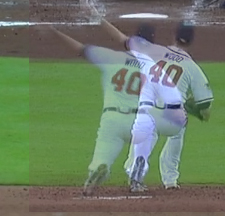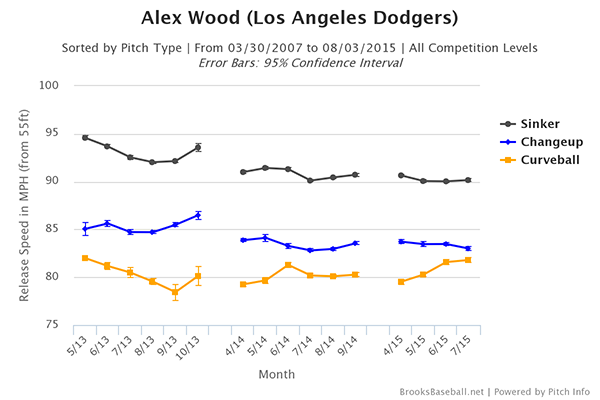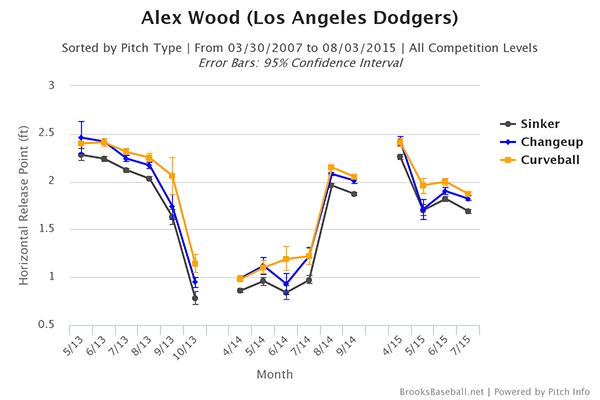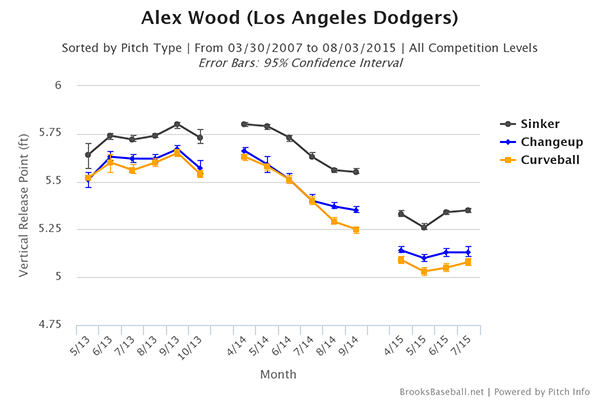After the 2014 season, Alex Wood was one of the most exciting young pitchers in the game. Before turning 24, he turned in a season that was worth nearly 3 fWAR and 4 RA9-WAR, pitching 172 innings of 77 ERA- and 88 FIP- baseball as a starter and a reliever. His 2013 debut saw similar flashes of brilliance. He wasn’t a superstar, but he was a very solid number two starter at such a young age. It would have cost an absolute fortune to acquire him on the trade market.
Wood’s ERA is up this season, but it matches his FIP, which has more or less held steady after adjusting for the increase in offense between the two seasons. However, his xFIP, which was almost identical to his FIP last year, has increased by half a run in 2015. 104 xFIP-, Alex Wood’s number from so far this season, certainly isn’t terrible (and is an upgrade from what the Dodger rotation had in the number five spot before last week), but it is a big step back from Wood’s 2013-2014 seasons. We’re starting to get into the point of the season where xFIP has diminishing returns for starters, but the issue here is more substantial than just lucky HR/FB rates.
The big problem that xFIP reveals is that Wood’s strikeouts have dramatically decreased. In his debut season, Wood had a strikeout rate of 23.6% and a strikeout-walk differential of 15.3%. Last season, those numbers jumped to 24.5% and 18.0%, which are both excellent. This year, Wood’s strikeout rate has fallen to 17.7% and his strikeout-walk differential has fallen to 10.6%. Among 92 qualified starters, these numbers rank 64th and 65th, respectively. That kind of sharp downward trend is alarming, particularly from a player who has had arm problems in the past (Wood had Tommy John surgery in 2009) and scary mechanics. Suddenly, it’s more clear why the Dodgers got him for a relatively cheap price.
The natural question is, “why did the strikeouts go away?” The answer to that is pretty murky, though, as evidenced by the long list of things to follow.
It’s not the velocity
Clearly, this is the first place to look. But, there’s no obvious problem here, as shown by the chart below:
Wood’s velocity has decreased, but the Braves had Wood in the bullpen for awhile in both 2013 and 2014. The higher velocities correspond to those dates. Wood’s strikeout and walk numbers were very similar as a starter and in relief last year, so the decrease in velocity as a starter didn’t correlate directly with decreased performance.
The pitch selection hasn’t changed much
Wood has always been a three-pitch lefty:
His sinker usage is up across the board, but that hasn’t necessarily caused the worse strikeout numbers. Against right-handed batters, all three pitches are seeing lower whiff rates and whiff/swing rates this year than they did last year. That’s concerning – even if the usage was redistributed more towards offspeed pitches, his whiff rate would still be lower than what it was.
The results have been more mixed against lefties. Wood very rarely throws his change to them. His sinker whiff rate is way down from previous seasons, but notably lefties are not making contact with the curveball as well as they have in the past. As a result, Wood should probably be throwing the curve against lefties more than he has been this year (usage down to 26%, from 31% in 2014). It won’t solve all of his problems, but it could be an improvement. This is also where having three pitches rather than four hurts Wood; having a slider to mix in against lefties would certainly help as well.
Pitches have the same movement
This post is already really media-heavy, so I won’t embed the images, but Wood’s pitch movement is nearly identical to previous seasons.
Batters are swinging at similar pitches
Pretty straightforward to check:
| In-zone Swing% | Out-of-zone Swing% | |
|---|---|---|
| MLB Average Starter, 2014-15 | 62.4% | 29.6% |
| Alex Wood starting, 2014 | 59.6% | 31.0% |
| Alex Wood, 2015 | 61.5% | 30.6% |
Batters are swinging more at in-zone pitches by Wood, but still at a rate lower than league-average. The out-of-zone swing rate is still virtually identical to last year, and above the league-average. Batters are still prone to watch strikes and swing at not-strikes. He’s almost like a less extreme Mike Bolsinger. The good news is that Wood should benefit disproportionately from the switch to Yasmani Grandal, an excellent pitch framer who can help steal a few more strikes.
Even though batters have marginally better pitch selection against Wood this year, contact rates have changed much more dramatically on both in-zone and out-of-zone pitches. In 2014, batters made contact on 63.7% of their out-of-zone swings and 86.7% of their in-zone swings against Wood. This year, those numbers have jumped to 72.5% and 90.0%, both worse than a league-average starter. Out-of-zone contact is weak contact, generally (as an aside, so far this season it hasn’t been for Wood – batters are hitting .277 and slugging .365 on Wood’s out-of-zone pitches put in play). A whiff is still preferable.
So, what is it?
The biggest visible change between Wood in previous seasons and Wood this year show up in his release point:
At the end of last year, Wood’s horizontal release point moved by about a foot, undoing a change that happened in the previous season. The vertical release point has drifted downwards, and it’s now about 6 inches lower than it was at the beginning of his sophomore campaign. There’s also more separation between the curve and change this year. The magnitude is tiny, but major leaguers are scary good and might be able to pick that up.
 The difference in release points, when compared visually, is pretty striking. Here is an April 2014 release point overlaid with one from two weeks ago. Both pitches are fastballs to right-handed batters, with some minor scaling applied in an attempt to offset an annoyingly inconsistent center field camera.
The difference in release points, when compared visually, is pretty striking. Here is an April 2014 release point overlaid with one from two weeks ago. Both pitches are fastballs to right-handed batters, with some minor scaling applied in an attempt to offset an annoyingly inconsistent center field camera.
The image isn’t 100% accurate, which can be seen by the slightly misaligned dirt in front of the plate. Still, the rubber and plate are in similar locations so it’s close enough for an internet article. Wood has shifted rubber positions dramatically, and his arm slot has also dropped a lot.
Overall, there are quite a few mechanical differences. Here are the two deliveries, side-by-side, played at 25% speed (gfycat lets you pause, too, if you right click on the image):
Here are the differences that I noticed:
- Arm slot and rubber position, as noted before
- Different posture on follow-through (more hunched, legs and feet at different angle on plant and follow-through)
- Ball position during set
- Pitching arm moves at different pace with respect to his body
- Slight frame hiccup on the right, frame rate isn’t quite constant
Whether or not that’s bad is not something that I can say with any sort of certainty. Alex Wood’s mechanics look painful even on a good day. But, when there aren’t many other differences to see in Wood’s Pitch FX numbers, this sticks out.
One theory: if Wood’s stride is shorter now than it used to be (hard to see from this angle), the perceived velocity of his pitches may be less now than it was before. These changes can also make it easier to pick up the ball out of Wood’s hand, or he might even be tipping if the batter can see the ball down by his hip (more an issue against right-handed batters than left). These aren’t very strong claims, but it’s something, which the data doesn’t reveal by itself.
The other theory: this goes back to command. It’s so hard to track numerically, but here are Wood’s percentage of pitches thrown ahead and behind in the count, by year:
| Year | % of pitches behind | % of pitches ahead |
|---|---|---|
| 2013 | 19.5% | 30.2% |
| 2014 | 20.1% | 30.5% |
| 2015 | 22.3% | 28.8% |
He’s taken a pretty big step back in this area in 2015. If he’s having trouble repeating his delivery due to the mechanical changes, this is one area where it would show up.
It’s a pretty good sign that it took this much digging to find a concrete change for Wood. If it’s just mechanical, it could be correctable. Remember, the Dodgers saw Wood twice this season, so it’s very possible that Rick Honeycutt or somebody beyond the scouting staff picked up on a way to fix the problems. It’s refreshing to see a buy low move with upside, which is the smart thing to do. If Wood’s strikeout trend can be reversed, he’ll be a very valuable addition to the Dodgers’ staff.
 Dodgers Digest Los Angeles Dodgers Baseball Blog
Dodgers Digest Los Angeles Dodgers Baseball Blog



